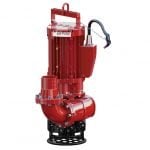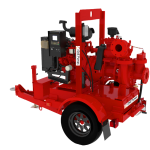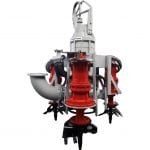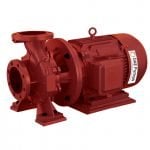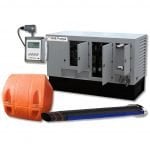Simplifying the Process of Selecting a Dredge Pump
September 06, 2022

This article shows the process of selecting a dredge pump for your application.
This Article Includes
- Basic Introduction to Selecting a Dredge Pump
- Definition of Slurry Pump & Dredge Pump
- Primary Selection Requirements for Dredge Pump Owners
- Knowing Your Slurry Type
- Critical Flow Rate Estimation
- Discharge Head Estimation
- Pump Power Rating
- Material Selection
- Different Types of Slurry Pump Installation
Need Help?
Our team of engineers is standing by to help you with your next project. Call us at (760) 821-8112 or submit a request.
Basic Introduction to Selecting a Dredge Pump
The selection of a dredging pump or slurry pump can be complicated. This could be easier if you understand the key factors to smooth operation. A dredge pump that delivers a higher performance is also more cost-effective requires less maintenance and lasts much longer.
This is because a higher-performing dredge pump can move more material in a shorter amount of time, reducing the project’s overall cost. In addition, a higher-performing dredge pump is less likely to break down, which means you’ll save money on repairs and replacement parts.

Definition of Slurry Pump & Dredge Pump
The mechanical device used for the pressure-driven transportation of fluid mixtures (aka slurry) is called a slurry pump. Fluid mixtures mainly consist of water, minerals, and other crushed materials. The pump is designed to handle these materials without clogging or damage. The pump is also designed to be durable and withstand heavy use.
The dredging process uses a specific type of heavy-duty slurry Pump called dredges. The process of moving underwater sediments, usually sand, gravel, and rocks, from one area to the next (a typical piece of dredging equipment can be seen in Figure 1) is known as dredging. Dredging is done for land reclamation and desilting of rivers, lakes, or oceans. It can also be used to flood-prevent, create new ports, or expand existing ones. The dredge pump is used by many industries, including the mining and construction industries, as well as the oil & gas, coal, and mining industry. These industries are all significant contributors to the economy and provide many jobs for people across the country. Without these industries, the economy would suffer greatly.
Primary Selection Requirements for Dredge Pump Owners
The two most important considerations when choosing a dredge pump for operation include no sediment settlement and minimal wear from the pump because of the flow operation. You must consider the following design criteria to meet these primary requirements: type of installation, critical flow rate; total discharge height; and material for the pump. In addition, other essential factors to consider include the size of the pump, the power source; the level of automation; the environment; and the application.
Knowing Your Slurry Type
It is crucial to understand the materials that will be used to transport the material before you can estimate the parameters for ‘your’ slurry pumps. The first step in determining the ideal pump design is to determine the pH, temperature, specific gravity, and content of solids. This will give you a good idea of what kind of pump will suit your needs. For example, if you have a high pH, you will need a pump to handle that.
Critical Flow Rate Estimation
The transition flow rate from a laminar to a turbulent flow is called the critical flow rate. This is calculated using the size of grain (size of slurry particles), solids concentration in the slurry, and pipe diameter. The pump flow rate of your actual pump must be greater than the critical flow rate calculated for your application to minimize settlement. This is because if the flow rate is too low, the particles in the slurry will have time to settle and clog the pump.
The pump flow rate should be chosen carefully, as an increase in flow will result in increased wear on the pump and abrasion. This can also reduce pump life expectancy. The pump’s flow rate must be optimally controlled to ensure uninterrupted performance and a longer life span. This can be done by monitoring the pump’s performance regularly and adjusting as needed to ensure optimal flow rate. Additionally, proper maintenance of the pump and surrounding equipment is essential to prolonging its life span.
Check Out Other DAE Pumps Products
Discharge Head Estimation
Critical flow rate describes the difference between turbulent and laminar flows. It’s calculated by grain diameter, the concentration of solids within the slurry, and the diameter of the pipe. You should set the pump flow rate at a higher level than what is calculated to be the critical rate. This will minimize the settlement of sediments. The critical rate is the point at which sediments begin to settle out of suspension in water and is affected by various factors, including the particles’ size and density and the water’s temperature and salinity.
You should choose the flow rate carefully. A higher flow rate can cause wear to the pump materials and decrease the life of the pumps. Therefore, pump flow rates should be optimized to maximize performance and prolong life expectancy. This could be done by ensuring that the pumps are regularly serviced, and the flow rates are monitored. By doing this, the pumps will be able to operate at their maximum efficiency and will last longer.
Pump Power Rating
The dredge determines power consumption from the discharge head, flow speed, and specific gravity of the pumped liquid. It would help if you verified that the pump’s power rating is more significant than its calculated power consumption, considering possible variations in operating conditions.
This means that the pump will be able to handle any unexpected spikes in power consumption that may occur during operation. The pump is designed to handle sudden increases in power consumption and will not be overloaded. This will ensure that the pump can continuously operate at peak efficiency and will not be damaged by spikes in power consumption.
Material Selection
The commonly used materials for the construction of slurry pumps include cast iron, stainless and high chrome. In addition, a few slurry pump models come equipped with a liner to help with the problems associated with slurry erosion. Some elastomers included in the lining are polyurethane, natural rubber, and Neoprene. These materials are all designed to resist the abrasive force of the slurry, as well as to provide a seal against leaks. In addition, the lining must be able to withstand the chemical attack of the slurry, as well as the high temperatures.
It depends on the slurry’s temperature and pH and the presence or absence of specific abrasive liquids. The slurry’s temperature and pH can significantly affect the process’s outcome, as well as the presence or absence of specific abrasive liquids.
Different Types of Slurry Pump Installation
According to the shaft orientation, a slurry pump can be horizontal or vertical. Vertical pumps have the shaft in the horizontal position, and the beam is aligned vertically in horizontal pumps. Vertical pumps are typically used for lower flow rates than horizontal pumps. Conversely, flat pumps are used for higher flow rates.
These are the most popular types of slurry pumps. Horizontal pumps have many advantages, including ease of maintenance and installation, comprehensive flow options, and various design materials. Vertical pumps have other benefits, however. They require less space to be installed. This will be important when trying to save space in a smaller home or office. Additionally, vertical pumps are less likely to be damaged by flooding or other water damage since they are not as close to the ground.
Dry and wet installation are other ways to distinguish between types of slurry pumps. Wet-installation pumps, such as the submersible pump, have their hydraulic ends and drive outside the liquid. Because submersible pumps are not supported, they don’t take up much space. The type of installation and operation desired will determine the best method to install the pump. For example, if you want a pump that can be easily removed for maintenance, you might want to consider a pedestal mount. This mount allows the pump to be easily lifted off the base for servicing.
DAE Pumps – Going Above and Beyond!
DAE Pumps is a premium industrial slurry pumps and dredge equipment manufacturer. Offering unparalleled performance for many different industries, DAE Pumps are ideally suited for Oil & Gas, Mining, Construction, Marine, Municipal, Water & Wastewater, and many other industries. Along with the high-quality pumps DAE Pumps offers, we also provide world-class service to assist you no matter what the pumping challenge.
DAE Pumps Product Categories
All pumps by DAE Pumps are made of the highest quality materials; they are durable, long-lasting, and provide value beyond your expectations. No matter your industry, DAE Pumps has a pump specifically suited for your needs.
Need Help?
Our team of engineers is standing by to help you with your next project. Call us at (760) 821-8112 or submit a request.



